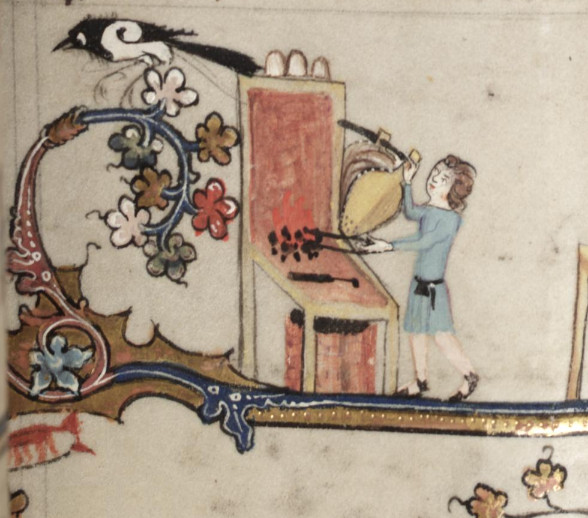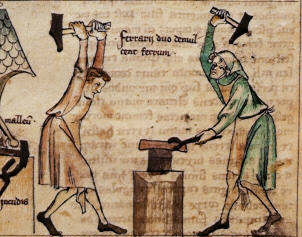Forge Building Part 1 - Research
August 2017
I’ve recently decided to build a blacksmithing forge and wanted to make it as historically accurate as possible. This is so that I can use it at re-enactment events, showcasing how blacksmithing would have occurred in that time period. Like most things re-enactment, the first port of call to build accuracy is through researching. My selected time period is approximately 1350-1370.
The complete forging setup I’ll be building contains 4 major parts. The first part is the forge itself, which contains a firebox used for the fire. The second is the bellows, which provides a constant stream of air to the firebox. The third is the Anvil used for performing the forging itself. And lastly, a grindstone to further refine any blade edges or shapes as needed.
This post is simply detailing the sources I’ve used to inspire the design I’ll be using. Other design considerations include ensuring the completed forge is resilient, as I have no desire to constantly repair this. A further consideration is its portability, as I’ll be transporting this to events.
Many of the sources are from manuscripts, I’ve made liberal use of the larsdatter website for locating links to various sources. This list is not extensive and may be updated from time to time as I discover new sources.
Forge/Firebox
Most sources that depict blacksmithing only show permanent stone forges. The only sources for a portable forge I have found, show a large wooden table with a large divider on one side. I’ve elected to be a bit more practical with my firebox, however, I will try and incorporate these elements into the frame for the firebox.
Sources
- The Romance of Alexander fol. 164v (Bodl. 264), 1338-1344
- The Romance of Alexander fol. 165r (Bodl. 264), 1338-1344
- The Romance of Alexander fol. 171v (Bodl. 264), 1338-1344

Bellows
The double lung bellows most people associate with blacksmithing does not appear in any sources for this period. I’ll be using dual bellows, connected up with a swinging arm, which can raise them one at a time.
Sources
- Hedroit makes the nails for the Crucifixion, the Holkham Bible Picture Book (British Library Add 47682, fol. 31r), c. 1327-1335
- The Romance of Alexander fol. 84r (Bodl. 264), 1338-1344
- The Romance of Alexander fol. 164v (Bodl. 264), 1338-1344
- The Romance of Alexander fol. 165r (Bodl. 264), 1338-1344
- The Romance of Alexander fol. 171v (Bodl. 264), 1338-1344
- Two blacksmiths, Liber Astrologiae (Brit. Lib. Sloane 3983, f. 5), second half of the 14th century
- The martyrdom of St. John, Bible (BNF Ned. 3, fol. 1), 14th-15th century

Anvil
Many of the sources for the anvil are the same as the sources for the bellows, as the two usually go hand in hand when depicting blacksmithing. I will be opting to use a small stump anvil, and stump tools, with a larger anvil for heavier work if required.
Sources
- A blacksmith, The book of the treasure (BNF Fr. 571, fol. 66v), c. 1326
- Hedroit makes the nails for the Crucifixion, the Holkham Bible Picture Book (British Library Add 47682, fol. 31r), c. 1327-1335
- Two blacksmiths, Liber Astrologiae (Brit. Lib. Sloane 3983, f. 5), second half of the 14th century
- Detail from the February fresco at Castello Buonconsiglio, c. 1405-1410
- Small 14th to 17th Century Stump Anvil

Grindstone
The depicted grindstones are all large, mounted in a wooden frame, and hand-operated. Due to the size, this would require an assistant. My plan is to use a smaller grindstone that can be used both by hand and foot.
Sources
- A grindstone turned by two men while a third man sharpens a knife, the Luttrell Psalter (Brit. Lib. Add. 42130, fol. 78v), c. 1325-1340
- Grinding a sword-blade - Romance of Alexander (Bodl. 264, fol. 113v), c. 1338-1344
- Detail from July in the frescoes at Castello Buonconsiglio, c. 1405-1410
